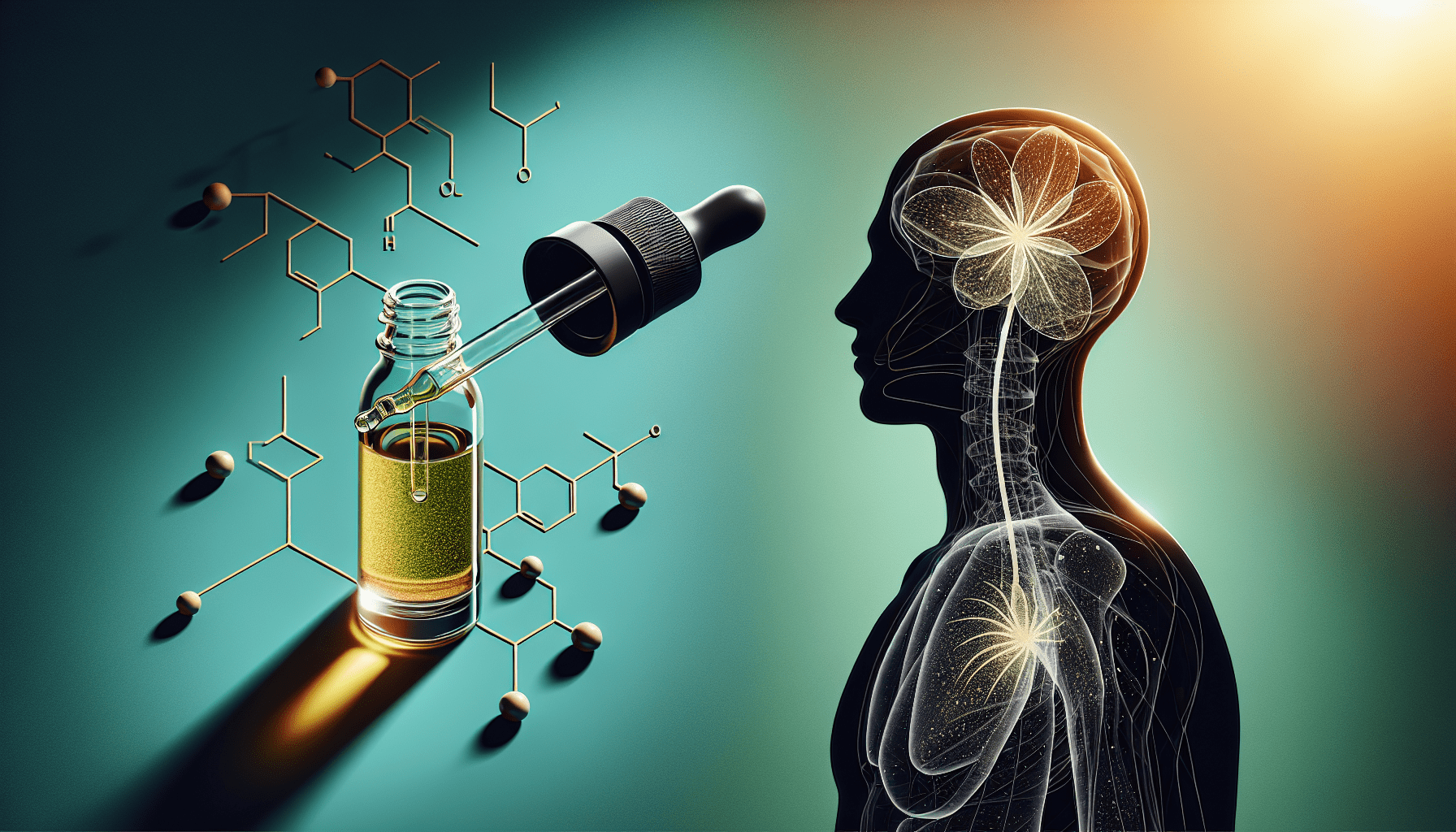Ever wondered how CBD interacts with receptors in your body? It’s a fascinating topic that has captured the attention of many curious minds. CBD, short for cannabidiol, is known for its potential therapeutic benefits, but understanding how it actually works on a cellular level can shed light on its wide-ranging effects. By exploring the intricate dance between CBD and receptors in the body, we can gain a deeper understanding of this natural compound and its potential to support our wellbeing. So, let’s take a closer look at the mysterious world of CBD and its interaction with our body’s receptors. Get ready to embark on a captivating journey of discovery!
Overview of CBD
CBD, short for cannabidiol, is a natural compound found in the cannabis plant. Unlike its counterpart, THC, CBD does not produce the psychoactive effects commonly associated with marijuana use. In recent years, CBD has gained significant attention for its potential therapeutic benefits and has become a sought-after remedy for various ailments.
Definition of CBD
CBD is one of the many cannabinoids found in cannabis. It is extracted from the plant and formulated into various products, such as oils, capsules, topicals, and edibles. CBD works by interacting with the body’s endocannabinoid system (ECS), a complex network of receptors and neurotransmitters that are involved in regulating many physiological processes.
Importance of CBD in healthcare
The use of CBD in healthcare has gained traction due to its potential to alleviate a wide range of symptoms and conditions. CBD has shown promise in managing anxiety, depression, chronic pain, inflammation, epilepsy, and neurodegenerative diseases, among others. Its non-intoxicating nature and minimal side effects make it an attractive option for individuals seeking natural alternatives to traditional medications.
Common uses of CBD
CBD has been utilized for various purposes, with its most common uses including pain management, stress relief, sleep improvement, and overall wellness support. Many individuals turn to CBD as a complementary therapy to their existing treatments or as a means of promoting general well-being. The versatility of CBD and its potential to address multiple health concerns has made it an increasingly popular choice among consumers.
Endocannabinoid System (ECS)
Explanation of ECS
The endocannabinoid system (ECS) is a complex cell-signaling system found in the body that plays a vital role in regulating various physiological processes. It consists of three main components: endocannabinoids, receptors, and enzymes. The ECS helps maintain balance, or homeostasis, within the body, ensuring optimal functioning of various bodily systems.
Relevance of ECS in the body
The ECS plays a crucial role in maintaining overall health and well-being. It helps regulate functions such as sleep, mood, appetite, immune response, pain perception, and inflammation. When there is an imbalance or dysfunction in the ECS, it can contribute to the development of various health conditions.
Key components of ECS
The ECS operates through a network of receptors located throughout the body. These receptors, known as cannabinoid receptors, provide sites for the interaction of cannabinoids like CBD. The two primary types of cannabinoid receptors are CB1 and CB2 receptors, each serving different functions in different parts of the body.
Interaction of CBD with ECS
CBD interacts indirectly with the ECS by influencing the activity of cannabinoid receptors and other receptors involved in the regulation of various physiological processes. CBD does not bind directly to the CB1 and CB2 receptors but rather modulates their functioning. This interaction ultimately leads to the potential therapeutic effects observed with CBD use.
Cannabinoid Receptors
Introduction to cannabinoid receptors
Cannabinoid receptors are large proteins found on the surface of cells throughout the body. They are part of the endocannabinoid system and play a crucial role in mediating the effects of cannabinoids like CBD and THC. By interacting with these receptors, cannabinoids can influence various physiological processes.
Types of cannabinoid receptors (CB1 and CB2)
There are two primary types of cannabinoid receptors: CB1 and CB2 receptors. CB1 receptors are primarily found in the central nervous system, including the brain, while CB2 receptors are predominantly found in the peripheral tissues, particularly in immune cells. Both types of receptors have distinct functions and are involved in different physiological processes.
Distribution of cannabinoid receptors in the body
CB1 receptors are found abundantly throughout the brain, particularly in areas responsible for cognition, memory, emotion, and motor coordination. CB2 receptors, on the other hand, are predominantly found in immune cells, the gastrointestinal tract, and other peripheral tissues involved in inflammation and immune response.
Interactions of CBD with CB1 receptors
CBD has been shown to have a low affinity for CB1 receptors, which are primarily responsible for the psychoactive effects associated with THC. However, CBD can indirectly influence CB1 receptor activity by modulating their functioning and reducing the binding affinity of other molecules, such as THC, to these receptors. This interaction may contribute to the potential anxiolytic and antipsychotic effects of CBD.
Interactions of CBD with CB2 receptors
CB2 receptors play a crucial role in immune function and inflammation regulation. CBD has been found to interact with CB2 receptors, leading to the modulation of immune response and inhibition of inflammatory processes. By targeting CB2 receptors, CBD may help alleviate inflammation and related conditions such as autoimmune diseases, arthritis, and gastrointestinal disorders.
CBD as a Partial Agonist
Explanation of partial agonism
In pharmacology, agonists are substances that activate receptors, while antagonists are substances that block receptor activation. CBD is considered a partial agonist, meaning it can both activate and inhibit receptor activity, depending on the context. This partial agonistic activity allows CBD to regulate receptor functioning without overstimulating or overwhelming the receptors.
CBD’s effect on CB1 receptor activity
As a partial agonist, CBD can interact with CB1 receptors and modulate their activity. CBD has been found to reduce the psychoactive effects of THC by inhibiting CB1 receptor activation. By reducing CB1 receptor stimulation, CBD may help mitigate some of the negative side effects associated with excessive CB1 receptor activation, such as anxiety and paranoia.
CBD’s effect on CB2 receptor activity
CBD’s partial agonistic activity also extends to CB2 receptors, which play a crucial role in immune function. By interacting with CB2 receptors, CBD can modulate immune response, reduce inflammation, and potentially alleviate symptoms associated with autoimmune diseases and chronic inflammation. CBD’s effect on CB2 receptor activity may contribute to its therapeutic potential in various inflammatory conditions.
CBD’s Influence on Neurotransmitters
Impact of CBD on serotonin receptors
Serotonin is a neurotransmitter that plays a vital role in regulating mood, sleep, appetite, and anxiety. CBD has been found to interact with serotonin receptors, particularly the 5-HT1A receptor. By binding to these receptors, CBD may increase serotonin levels in the brain, leading to potential antidepressant and anxiolytic effects.
Effects of CBD on anandamide levels
Anandamide is an endocannabinoid that interacts with cannabinoid receptors in the body. CBD has been shown to inhibit the enzyme responsible for breaking down anandamide, resulting in increased levels of this endocannabinoid. By modulating anandamide levels, CBD may help regulate various physiological processes, including pain perception, mood, and appetite.
Interaction between CBD and dopamine receptors
Dopamine is a neurotransmitter associated with motivation, reward, and pleasure. CBD has been found to indirectly influence dopamine levels in the brain by interacting with receptors involved in dopamine regulation. This interaction suggests that CBD may have potential implications in conditions related to dopamine dysregulation, such as schizophrenia and addiction.
CBD’s Role in Inflammation and Pain
Introduction to CBD’s anti-inflammatory properties
One of the key therapeutic properties of CBD is its anti-inflammatory effect. CBD has been shown to reduce inflammation by interacting with various receptors and pathways involved in the immune response. By dampening inflammatory processes, CBD may help alleviate symptoms associated with chronic inflammation and related conditions.
Effects of CBD on immune response
CBD’s interaction with CB2 receptors in immune cells can modulate immune response and attenuate the release of pro-inflammatory substances. This immunomodulatory effect of CBD may help reduce inflammation and prevent excessive immune activity, which is often associated with autoimmune diseases and chronic inflammation.
CBD’s impact on pain perception
CBD has been found to interact with receptors involved in pain modulation, such as TRPV1 receptors. By desensitizing these receptors, CBD can potentially reduce pain perception. Additionally, CBD’s anti-inflammatory properties may indirectly contribute to pain relief by reducing inflammation, which is often associated with pain.
CBD’s Interaction with Non-Cannabinoid Receptors
Overview of non-cannabinoid receptors affected by CBD
In addition to cannabinoid receptors, CBD also interacts with various non-cannabinoid receptors in the body. These interactions expand the therapeutic potential of CBD and contribute to its diverse effects on different physiological processes. Some of the key non-cannabinoid receptors affected by CBD include TRPV1 receptors, adenosine receptors, and PPAR receptors.
CBD’s influence on TRPV1 receptors
TRPV1 receptors play a crucial role in pain perception and temperature regulation. CBD has been found to interact with TRPV1 receptors, leading to the desensitization of these receptors and a potential reduction in pain sensation. By modulating TRPV1 receptor activity, CBD may offer an alternative approach to managing chronic pain.
CBD’s effects on adenosine receptors
Adenosine receptors are involved in regulating various physiological processes, including sleep, anxiety, and inflammation. CBD has been shown to interact with adenosine receptors, leading to potential anti-anxiety and anti-inflammatory effects. By modulating adenosine receptor activity, CBD may help promote relaxation and reduce inflammation in the body.
CBD’s interactions with PPAR receptors
PPAR receptors, specifically PPAR-gamma, are involved in regulating gene expression and inflammation. CBD has been found to interact with PPAR-gamma receptors, potentially reducing inflammatory responses. CBD’s interaction with PPAR receptors may contribute to its anti-inflammatory properties and its potential therapeutic effect in conditions associated with inflammation.
Potential Therapeutic Applications
CBD’s role in managing anxiety and depression
Anxiety and depression are common mental health disorders that affect millions of people worldwide. CBD has shown promise in alleviating symptoms associated with anxiety and depression by influencing serotonin receptors and reducing inflammation. CBD’s anxiolytic and antidepressant effects may offer a natural alternative to traditional medications for those seeking relief.
Use of CBD in treating epilepsy and seizures
CBD has gained considerable attention for its potential in treating epilepsy and seizures, particularly in severe and treatment-resistant cases such as Dravet syndrome and Lennox-Gastaut syndrome. The exact mechanisms of CBD’s anticonvulsant effects are not fully understood but are believed to involve interactions with various receptors and modulation of neurotransmitter release.
Potential anti-tumor properties of CBD
Emerging research suggests that CBD may possess anti-tumor properties and could potentially be used as an adjunctive treatment for cancer. CBD’s anti-inflammatory and anti-proliferative effects, along with its ability to induce apoptosis (programmed cell death), have been investigated as potential mechanisms underlying its potential anti-cancer activity.
CBD’s impact on neurodegenerative diseases
Neurodegenerative diseases, such as Alzheimer’s and Parkinson’s, involve the progressive degeneration of brain cells. CBD has shown promise in preclinical studies for its neuroprotective and anti-inflammatory properties, which may help slow down the progression of neurodegenerative diseases and alleviate associated symptoms.
Interactions with Other Medications
Overview of potential drug interactions
It is important to consider potential drug interactions when using CBD, as CBD can interact with enzymes involved in drug metabolism. CBD inhibits certain enzymes, particularly cytochrome P450 enzymes, which are responsible for metabolizing many medications. This inhibition can affect the metabolism and effectiveness of certain drugs, potentially leading to adverse effects or decreased drug efficacy.
CBD’s influence on enzyme system activity
CBD’s inhibitory effect on cytochrome P450 enzymes can result in altered drug metabolism and potentially impact the efficacy and safety of medications that are metabolized by these enzymes. It is crucial to consult with a healthcare professional when considering combining CBD with other medications to ensure proper dosage adjustments and avoid any potential adverse interactions.
Cautionary notes for combining CBD with specific medications
Certain medications, such as blood thinners and anti-epileptic drugs, may have a narrow therapeutic window and require precise dosing. Combining CBD with these medications may increase the risk of adverse effects or alter their therapeutic effects. It is important to discuss the use of CBD with a healthcare professional, especially when taking medications with a known interaction potential.
Further Research and Potential
Ongoing studies on CBD’s receptor interactions
Research on CBD’s interactions with receptors in the body is still ongoing, with scientists continuously uncovering new insights into its mechanisms of action. Ongoing studies aim to further elucidate the specific receptors and signaling pathways involved in CBD’s therapeutic effects, allowing for the development of optimized CBD-based treatments.
Exploration of additional receptor targets
While CBD’s interactions with cannabinoid receptors, serotonin receptors, and other known targets have been extensively studied, there is still much to explore in terms of other receptors and signaling systems that CBD may modulate. The exploration of additional receptor targets may contribute to the discovery of new therapeutic applications for CBD.
Future implications for CBD-based therapies
With the increasing interest and research surrounding CBD, the future holds great potential for the development of CBD-based therapies. As scientists unravel the intricate biological mechanisms underlying CBD’s effects, there is hope for the development of targeted CBD formulations and precise treatment protocols for various conditions. The evolving field of CBD research may pave the way for innovative approaches in healthcare and improve the quality of life for many individuals.
In conclusion, CBD interacts with receptors in the body, particularly within the endocannabinoid system. Its interactions with cannabinoid receptors, as well as non-cannabinoid receptors, contribute to its wide range of potential therapeutic applications. From managing anxiety and depression to alleviating pain and inflammation, CBD’s impact on various physiological processes highlights its potential as a versatile and natural alternative in healthcare. Ongoing research and exploration of CBD’s receptor interactions offer exciting possibilities for the future of CBD-based therapies in improving overall health and well-being.





